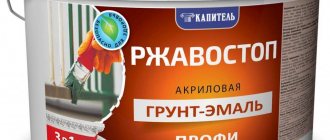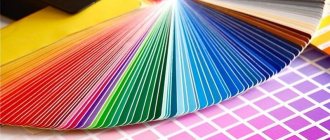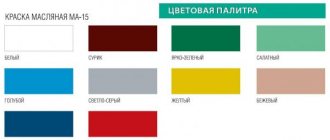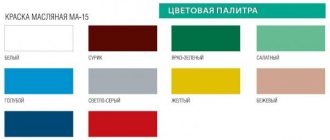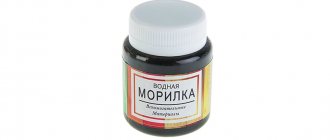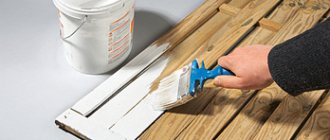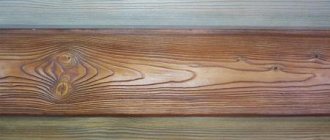The history of the development of automobile enamels dates back to those distant times when car bodies were no different from carriages and were painted with oil paints, dozens of layers of which dried on the bodies for several weeks. Since then, car paints have come a long way and today we are offered a huge selection of products in beautiful packaging with bright names. Let’s try to figure out what types of automotive enamels exist, how some paints differ from others, and at the same time, let’s refresh our memory of the main milestones in the evolution of auto enamels.
“The car can be any color, as long as that color is black.” At first glance, it might seem that this is just another of the oddities of the wayward Henry Ford. But no, the “car king” was not at all a hater of other colors - it’s just that in those days the only quick-drying material that was suitable for conveyor painting of vehicles was black natural Japanese varnish. The situation changed radically with the invention of nitrocellulose-based paints.
Nitro enamels. From gunpowder to paints
More than two hundred years ago, in 1800, French economist and politician Pierre Dupont immigrated to America with his two sons and their families. Once there, the Du Ponts decided to open a gunpowder factory. One of the sons, Eleuther Dupont, had to do this, since he was familiar with gunpowder firsthand: in France, he worked at the state gunpowder factory under the leadership of the great Antoine Lavoisier.
No sooner said than done. In 1802, in Delaware, near the city of Wilmington, work began on the construction of a new gunpowder factory, soon after which boxes with the inscription “DuPont. Explosives" (explosives).
For a long time, the Du Ponts dealt only with gunpowder, but at the turn of the 20th century they decided to start producing other goods. To do this, they built a large laboratory and hired several dozen chemist scientists. Thus began an era of revolutionary discoveries, including: the first synthetic rubber (neoprene), the first artificial fiber (nylon), cellophane, Teflon, lycra, Kevlar and many others. The name DuPont thundered throughout the world.
The history of the development of automobile paints almost coincides with the history of these discoveries. In 1923, when processing cellulose fibers, chemists obtained the world's first nitro paint, which made a real technological revolution in the automotive industry. Unlike oil paints, which were applied with brushes and dried at a snail's pace, nitro paints could be applied using pneumatic sprayers and dried almost instantly. All this led to the hegemony of nitro enamels in the automotive world.
But these paints also had disadvantages. Due to its low gloss, the coating required frequent polishing (in the twenties, linen rags and polishing pastes were used for this). And the painting process itself was long and laborious. Due to the low dry residue, the nitro enamel film was too thin and brittle, so 5 to 11 layers of enamel were required to obtain a durable coating.
By the way, this is exactly how government “Chaikas” and “Zilas” were painted during the Soviet Union. The coatings of these “member carriers” consisted of up to 12 layers! Moreover, during the painting process, the application of each subsequent layer of enamel alternated with careful polishing of the previous one, and the last layer was necessarily treated with wax polishes.
Needless to say, cars painted this way looked great. There was absolutely no shagreen on their surface, the paintwork gave exceptionally beautiful, clear highlights and reflections. Later, however, the whole thing had to be almost constantly tinted and polished - fortunately there was someone...
Relatively old Rolls-Royces and Cadillacs were painted using the same technology. For example, this is what a 1938 Cadillac 60 Special looked like, painted with nitro paint.
Let's talk about the film formation mechanism of nitro paints. What do you think is the reason for their polymerization? It's a tricky question - no polymerization actually occurs in nitro paints. These paints harden, or rather simply dry, solely due to the evaporation of solvents. That is, due to a purely physical process.
The resulting film after drying is reversible, which leads to another disadvantage of nitro paints: the coating has low resistance to aggressive influences, such as gasoline and sunlight.
The disadvantages of nitro paints forced paint manufacturers to look for ways to obtain new, more durable and easier-to-use materials. Although, despite all the disadvantages of nitro paints, it is still worth giving them their due - for their time they were very good.
By the way, nitro paints are still produced (you can identify them by the NC marking). Of course, they are almost never used in car repair. They are mainly used by restorers of rare cars or owners of old special equipment such as tractors and bulldozers. And then only in order to prepare such equipment for inspection as cheaply as possible.
Areas of application
Nitro enamels were originally developed as a coloring composition for cars. The main reason for this purpose is the glossy, spectacular mirror-like shine of the surface. However, the painting process was characterized by increased labor intensity, and besides, the coating was unstable: it only lasted for 3-5 years. Therefore, the industry gradually abandoned painting car bodies with nitro paint, although car enthusiasts still use this type of paint at home.
Now nitro enamels are most often used to treat the following types of surfaces:
- Metal. This can be any kind of building structure (railings, shelves, etc.) or a car body.
- Wood. Furniture, wooden panels, window sills, etc. are painted with nitro enamels.
- Walls covered with plaster.
Note! Paint is produced in markers specifically for applying inscriptions. The marker is a reservoir with a rigid tip (rod).
Age of Alkyd
The next stage in the history of car painting is associated with the advent of alkyd enamels. This happened at the turn of the 30s and 40s. Over the next 30 years, these enamels were the main paint and varnish material both on the assembly lines of automobile factories and in repair shops. The production of alkyd enamels was carried out by all leading manufacturers of paints and varnishes, including such giants as BASF and PPG.
Compared to nitro paints, alkyds have a number of technological advantages. They have a higher dry residue, so applying five to ten layers of enamel is unnecessary, two or three are enough. There is now no need for constant polishing of the coating - after complete curing, the alkyd enamel forms an irreversible film with high hardness, gloss and resistance to gasoline, oils, precipitation and sunlight.
What is alkyd enamel? The basis of these paints is alkyd resin - a product of the interaction of polyhydric alcohols and polybasic acids (combine fragments of the words alcohol (alcohol) and acid (acid) and you will understand the origin of the term “alkyd”).
The most common alkyd resins are glypthal resins (a product of the reaction of glycerin (trihydric alcohol), phthalic anhydride and vegetable oil) and pentaphthalic resins (pentaerythritol (tetrahydric alcohol) plus the same phthalic anhydride). Based on these resins, Russian paint and varnish manufacturers produce varnishes and enamels marked GF and PF. You may have come across jars with this marking in hardware or construction stores. These are classic alkyd materials.
Just do not confuse construction and household alkyd enamels with those intended for car repair. As an example of car repair “alkyds” we can cite the well-known Finnish enamel, we can recall the enamel “Vika-alkyd” (Vika-60) from.
Alkyd enamels cure naturally. Oxygen from the air takes an active part in this process (therefore, such enamels are often called “air-drying enamels”). Only, unlike nitro paints, here, in addition to physical drying (evaporation of the solvent), another process occurs in parallel: a chemical reaction of converting binder molecules into polymer.
To start the second, chemical process, the interaction of two reactive components is necessary. One of these components is found in the paint can - it is a solution of alkyd resin modified with vegetable oil. Vegetable oil supplies the product with “tails” of higher unsaturated fatty acids containing conjugated double bonds.
The second component is air oxygen. It interacts with these double bonds, resulting in the appearance of radicals that “trigger” the “cross-linking” reaction. Moreover, the presence of several double bonds in each molecule of the alkyd component leads to chain growth and branching and the formation of network structures that form the basis of a durable polymer film. It is impossible to dissolve such a film after it has completely cured, which is why it is called irreversible.
Alkyd enamels are considered one-component (they are supplied in one can), but from a physico-chemical point of view they can be considered two-component, since two components are always involved in their curing: alkyd resin and oxygen.
The very mechanism of curing of alkyd enamels also determines their main drawback: a very long curing time. Since the access of oxygen into the layer becomes more difficult as it cures, complete polymerization of alkyd enamel throughout its entire depth occurs in a few weeks at best. And the film obtained after the first time of painting is the result of only primary polymerization.
But these enamels are unpretentious in work; painting with them is convenient and easy. Due to the high content of solvents, a surface film quickly forms during the application process, so in order to create smudges, you still need to try. For these reasons, some craftsmen can still use alkyd enamels in certain cases. For example, to quickly and inexpensively refresh your used car before selling it. It turns out beautifully, but the new owner will have to think about the rest...
"Synthetics"
In 1956, melamine began to be added to alkyd resins. Melamine-alkyd enamels have long had a common name: “synthetics”. Why? One version is due to the fact that synthetic fatty acids were used to create the alkyd part of these enamels. Melamine alkyd enamels are produced under the ML marking.
During the curing of these enamels, two processes also occur simultaneously: evaporation of the solvent and the formation of an irreversible film. The second process also occurs with the participation of two components: an alkyd component modified with vegetable oil (or a solution of polyester resin) and melamine-formaldehyde resin. Both of these components are initially located in the same jar, for the time being without reacting with each other.
Unlike classic alkyd enamels, the alkyd component in melamine-alkyd enamels contains few double bonds, so it (the alkyd component) here practically does not react with oxygen. But this component necessarily contains units with reactive hydroxyl groups OH, and when the temperature rises, they react with the methylol groups of the melamine alkyd resin...
Simply put, with sufficient heat, a reaction occurs between the two components, in which the melamine-formaldehyde resin acts as a hardener.
As a rule, the required heating temperature for enamels is 130°C (for example, for Vika-syntal ML-1110). With this heating, the enamel dries in only 30 minutes.
Because of this feature, melamine alkyd enamels are also called “heat-drying enamels.” The advantages of this mechanism are obvious: unlike oxygen curing, here polymerization occurs evenly over the entire thickness of the layer. As a result, a durable irreversible film is formed, which in its physical and visual characteristics is not much inferior to acrylic (we’ll talk about it later) - but only under the condition of high-temperature drying in a chamber.
Since under conditions of repair painting it is impossible to achieve such high temperatures as at the factory, special isocyanate-based drying accelerators were used to reduce the drying temperature of these enamels. These unique “hardeners” were a good help for craftsmen who painted with “synthetics”.
Often in garages they painted with “synthetic” and without drying at all. Naturally, in this case one could not even dream of a tolerable quality of coating, but in conditions of shortage, when getting hold of “ML-coy” was not an easy task, many were happy with this. And besides the car, one could find something to paint with it. For example, a boat, a dacha, windows, railings...
The era of alkyd enamels and their modifications lasted until the mid-70s. Whatever one may say, these materials, with their long drying time and the need for hot drying, were also far from ideal. And progress went further...
CM application technology
The base from any material is pre-prepared.
Metal coating algorithm
- The surface of the metal is processed with sandpaper.
- Use acetone, white spirit, or gasoline to degrease metal with oil stains. If it is not possible to remove dirt with a cloth, the product can be immersed in a container with solvent. There is a special paste for large products.
- A primer is applied to the metal.
- Nitro paint is applied to a dry and clean surface. Multilayer coating.
Acrylic revolution
Our painters first became acquainted with acrylic coatings in the early nineties, although in other countries acrylic had probably been used for 30 years at that time.
Let's try to figure out why acrylic is so revolutionary. First, let's take a look at the containers in which these paints and varnishes are sold.
Unlike the enamels discussed above, here we see in front of us not one, but two cans: in one there is a base, in the other there is a hardener.
The components of acrylic coatings, unlike melamine-alkyd ones, cannot be stored in one container, since they will immediately react. Therefore, these products are supplied in two packages, the contents of which are mixed immediately before use. These are two-component materials (2K).
Let's say we mixed the components and applied acrylic enamel or varnish. To understand how curing occurs, we need to take a closer look at each of the components.
The first component contains a solution of acrylic copolymer. This is a high-molecular substance, a product of co-polymerization of acrylic monomers - acrylic and methacrylic acids and their esters. It is important for us now to understand that this copolymer contains units with hydroxyl OH groups. Remember.
Now about the second component - the hardener. It contains a polyisocyanate containing isocyanate groups -N=C=O. These are highly reactive compounds; they easily react with hydroxyl groups OH. This process underlies the curing of acrylic materials: when the copolymer solution and the hardener are mixed, the hydroxyl and isocyanate groups react according to the following scheme:
From the diagram we see that as a result of the reaction, a urethane bond is formed (the structure to the right of the arrow). And due to the fact that the isocyanate groups have the form of three-rayed stars (conditionally), the polymer, again, turns out to be “spatially cross-linked”.
Isocyanate groups can be conventionally depicted as three-rayed stars
Thus, when the acrylic film cures, polyurethane is formed (therefore, such enamels are also called polyurethane or acrylic-urethane). It is polyurethane that provides the coating with those excellent visual and consumer properties for which acrylic materials are famous.
The described mechanism is the main difference between acrylic coatings and enamels of previous generations. We can say that now the curing of paintwork materials has become a controlled chemical reaction, thanks to which painters are no longer dependent on many random factors.
The most important advantage of this method in practice was a significant reduction in the time for complete curing of paintwork materials. Thus, at an air temperature of 20 ° C and normal humidity, all irreversible changes in the acrylic coating are completed in 16-18 hours, and within a few more days the paintwork acquires maximum hardness. At a temperature of 60 °C, the coating completely polymerizes in 40-60 minutes, after which the car will be completely ready for polishing.
Two-component acrylic-urethane enamels with a physical and chemical curing mechanism are a step forward from nitro paints and alkyds. These materials allow you to obtain better coating quality and simplify the technological cycle
The finished film of acrylic enamel has high hardness (close to the hardness of glass), lasting gloss, excellent elasticity and wear resistance. Acrylics are resistant to acids, alkalis and solvents, have excellent adhesion to a wide variety of surfaces, and withstand exposure to sunlight and precipitation.
The advent of acrylic paints and varnishes opened a new era in body repair, making it possible, even in garage conditions, to create a coating comparable in quality to the factory one. This is why everyone loves acrylic.
Solvent for NC compositions
NC paints are diluted for application with a spray gun. They are usually ready to use and quite liquid.
For optimal consistency, a solvent for nitrocellulose products R-647 is used (0.4 kg container for 80.0 rubles, TEKS brand). It is an organic-based liquid, colorless, with an unpleasant odor. Components: esters, alcohols, aromatic hydrocarbons. The solvent for nitro enamel is introduced into the composition slowly so that fire safety measures are observed. Fires are localized with a carbon dioxide or foam fire extinguisher.
Beauty, and that's all. "Metallics" and "pearl"
The next step in the evolution of coatings is associated with the emergence of “spectacular” coatings.
Back in the era of alkyd, paint and varnish developers came up with the idea of adding tiny particles of aluminum powder to the enamel, which, like micro-mirrors, would reflect the light falling on them and give the coating a sparkling, “metallic” effect.
But the first “metallics” did not gain widespread popularity. These were very short-lived coatings, since aluminum flakes added to alkyd enamel caused rapid fading and clouding of the enamel.
And the spectacular capabilities of the first generation metallics left much to be desired. Since it was a single-layer (single-stage) system, it was impossible to achieve any impressive visual effects. Such “metallics” can be found, for example, on old bicycle frames. You can only see metal inclusions there under a magnifying glass.
And then paint and varnish manufacturers took a different route: they created a two-layer system “base enamel + clear varnish”.
Basic enamels are characterized by the fact that they contain a lot of solvent and dry quickly, but on their own, without varnish, they look rather poor, and their resistance to external influences is poor. But as soon as you apply the varnish, a wonderful metamorphosis immediately occurs: the coating “comes to life” and becomes fabulously beautiful, color saturation and depth appear.
Two-layer coatings turned out to be not only more beautiful, but also more durable and stronger. The colored layer is located under a durable varnish shell, which reliably protects the coating from aggressive external influences, especially from sunlight (a merciless destroyer of polymers).
From a chemical point of view, transparent varnishes are similar to the acrylic paints and varnishes described above, with the obvious difference being the absence of color pigments. Varnishes can be not only glossy, but also matte. And there is even an adjustable shine.
As for base enamels, they can be produced in different ways. A common option is a combination of polyester, cellulose acetobutyrate (reminiscent of NC, only UV-resistant unlike nitrocellulose) and melamine-formaldehyde resin (reminiscent of ML-ku).
At first, only aluminum was added to base enamels, but in the late 80s, particles of processed mica began to be used as effect pigments. This is how paints with the “pearl” effect appeared - similar to “metallic”, but with a more delicate, calm shine. Unlike flat aluminum particles, which reflect sunlight at a certain angle, “pearl” particles scatter the incident light, which gives the effect of a noble, “matte” shine.
Improvement of the effective capabilities of paintwork continues constantly. If earlier metallics with fashionable names “wet asphalt” or “champagne splashes” were a luxury item, today the market offers three-layer “mother of pearls”, “xyrallics”, and “chameleons”. And what will happen next is completely unknown.

